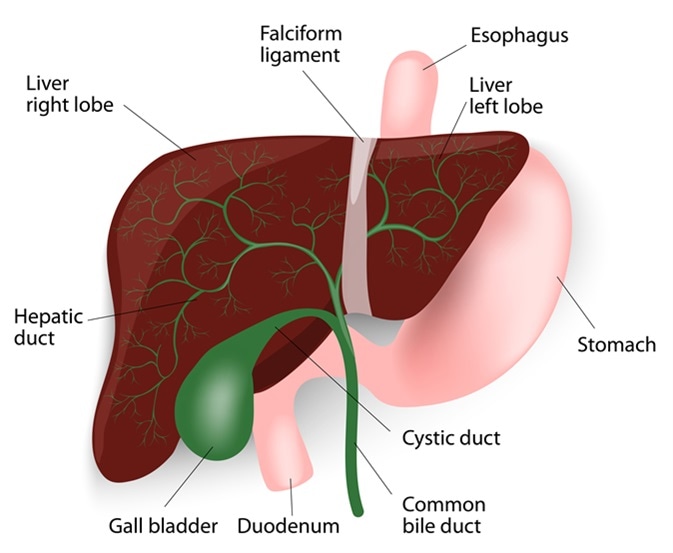Cancer in the bile ducts may not present with any symptoms in the initial stage. The bile duct is found in the inner part of the body and, therefore, it is difficult to detect early tumors during normal physical examinations. When the tumor at this stage grows and moves from the original location, it begins to exhibit symptoms.
Understanding Liver and Bile Duct Cancer
Symptoms
Depending on the location of the tumor in the bile ducts, the symptoms may vary; however, they generally include the following:
The skin and whites of the eyes turn yellow due to jaundice
The most common symptom in bile duct cancer is jaundice, although jaundice can be non-cancerous in most cases. The first identified factor in a person having bile duct cancer is the yellowed skin and eyes. Also, for such patients, the covering of the inner parts of the body, such as the nose and mouth, has a mucus membrane.
Bile (fluid) is made by the liver and then it is passed into the small intestine for further functioning. Jaundice can occur when the tumor in the liver obstructs the building up of bile, and hence the bile cannot flow into the intestine.

Human Liver Anatomy. Image Credit: Designua / Shutterstock
Blockade of the bile duct is caused by the presence of a yellowish-green chemical substance called bilirubin in the liver. This bilirubin then turns back into the bloodstream, body tissue, or sometimes settles in the inner part of the body.
The yellow pigment present in the bile changes the white part of the eyes and the skin to a yellow color. Different types of jaundice are known to occur from other diseases, among them post-hepatic jaundice or obstructive jaundice is the one that is caused by bile duct cancer.
The accurate cause of the jaundice has to be diagnosed and identified by the doctor, because multiple diseases related to jaundice are not critical or life-threatening, and cancer of the bile duct is one of the lesser general causes.
Itching
Itchy skin is a common temporary irritation that affects all people. In some rare incidences, it may lead to severe problems. People affected with bile duct cancer may have a sense of irritation due to the presence of higher amounts of bilirubin in the skin that comes from the blood. Itching is commonly identified in many patients with the disease.
Clay colored stool
Brown is the most normal color of stool, but in bile duct cancer patients the stool is very light in color. Owing to large accumulation of bilirubin in the duct, the bile may not be able to reach the intestine.
In such people, fatty foods are not digested easily because the tumor obstructs the flow of the fluid and pancreatic mixture into the small intestine. The unusually pale color stool occurs due to the presence of these undigested fats. The stool may be greasy and bulky and tend to float in the toilet.
The bilirubin concentration varies the stool color from pale yellow to nearly black. The stool turns to green or yellow in color due to the changes happening in the chemical structure of the bilirubin.
If the liver produces less amounts of bilirubin or there is a dilution of the fecal matter, it causes yellow stool. Variations in color of stool also occur due to the presence of digestive enzymes and bacteria in the small intestine acting on the bilirubin. Different interpretations are designated for changes in stool color.
Dark urine
When bilirubin levels in the blood rise, it may also affect the color of urine, which has a dark appearance.
Weakness
Too much work done in a short period of time leads to weak and tired muscles. But, bile duct cancer patients complain of a general weakness of muscle or physical strength and the feeling that additional effort is needed to move the legs, arms, or other muscles.
Abdominal pain
A common symptom of the bile duct cancer is abdominal pain; but, this appears only in the advanced stages and not in the early stages. Usually, the pain develops from the right side of the abdomen, just underneath the ribs.
Swollen abdomen
Enlargement of the abdomen occurs due to the pressure of cancer in the nearby organs.
Fever
People affected with jaundice may develop fever due to inflammation in the bile ducts. At high body temperatures the patient has shivering and feels cold.
Unexplained weight loss
The bile duct tumor patients may not feel hunger. Without maintaining proper diet, they can easily lose weight.
Nausea and vomiting
Abnormality in liver functions or the development of bilirubin may produce nausea. It may also occur along with fever due to the infection caused by the obstruction of the bile duct.
When these symptoms begin to manifest and are noticed, one should immediately consult with the doctor and confirm if they have cancer or some other disease. Depending upon the diagnosis, treatments will be decided.
Further Reading
Last Updated: Dec 28, 2022